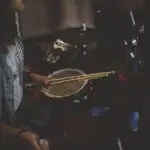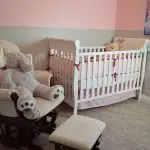Is soundproofing a closet for recording possible? Yes, it definitely is! There are several ways to soundproof a closet, all fairly cheaply.
One of the problems with living in an apartment is noise. It’s either you are disturbed by your neighbors or you disturb your neighbors. And, if you want to use your apartment as a recording studio, you’ll need to deal with all that noise.
Minimizing noise means could mean limiting your actions. If you’re a person who loves singing, it’s a big challenge for you – how can you sing effectively, when you have to keep your voice down?
How can you sing and record your songs without disturbing your neighbors? Likewise, how can keep external noise out of your music recordings?
The quick solution is to create a soundproof closet to use as a recording studio. Yes, you read that right. A small closet will do for recording – you just need to soundproof the closet. If you have a walk-in closet, that’s definitely your best option. A walk-in closet is big enough to hold the recording equipment and may have enough room to move around and play musical instruments in – and it has a door.
There are hundreds of materials you can use to soundproof a closet, starting as cheaply as adding carpet, hanging some fabrics, and adding a little weather stripping. But in this guide, I’ll only be focusing on a few that I found effective.
Table of Contents
Realistic Expectations for Your Soundproof Walk In Closet
Of course, professional recording studios are custom-built to ensure great sound quality, which is more than you can expect when creating a soundproof closet by adding sound dampening material after the fact, and even in a way that it can be removed later. But, there’s a lot we can do to minimize sound travelling through the walls without major construction.
If you own your house, you can get a bit fancier, by adding another layer of drywall to all the closet walls, with Green Glue soundproofing adhesive in between. However, if you’re renting, of course, you’ll probably need to be able to remove whatever materials you’ve added. (So, you may want to seriously consider removable acoustic panels.)
The Simple Process to Soundproof a Closet
Here’s the easy, step-by-step process to soundproof a closet.
Remove the Racks if There Are Any
The first step you should take is to remove any racks or shelves that are in your closet. Declutter the space to maximize it. (It also helps with sound dampening to remove any hard surfaces that can bounce the sound around.)
You want to provide enough space for the soundproofing materials you’ll be using later. Let go of those boxes, clothes, and racks.
If you have some built-in racks though, you don’t have to remove them. What you can do is to cut the soundproofing materials to fit around them. Or, you can apply acoustic panels to the shelves, to prevent sound from bouncing around.
Install Power Outlets
If you want to bring musical instruments inside your recording studio, you’ll need power outlets to plug the instruments in. So, consider installing any power outlets before proceeding with installing soundproofing.
If installing an electrical outlet is not possible, you can use an extension cord. The best way to do this is by drilling a hole in the wall, where you want to run the extension cord. The reason why I suggest this, is because if you just let the wire pass through the doorway, the door will need to remain open during the recording. This is not a good idea because the open door offers an opportunity for sounds to enter the closet.
Use Mass Loaded Vinyl to Soundproof the Closet Walls
When it comes to soundproofing a closet for recording, Mass Loaded Vinyl (click here to see this material on Amazon) is one of the most effective soundproofing materials. Mass-loaded vinyl (MLV) is a sound-dampening product used everywhere from nightclubs to recording studios to hockey rinks, and it’s among the best materials available for reducing sounds.
Once you have the closet empty, and have provided for power outlets, the next thing you’ll be doing is to make accurate measurements on the walls and ceiling that you want to soundproof. Then, cut the MLV according to those dimensions.
Once you have the material cut to size, you’ll want to stick it to the walls. If you’re installing large sections at a time, you’ll want a helper, since this stuff is heavy. The preferred way to attach MLV to a closet wall is to use nails or screws. And, be sure the nails or screws go into studs, so they don’t just pull out of the drywall. You may be able to use a spray adhesive, but it could react with the MLV, so choose wisely. Some people recommend using Green Glue – a very popular soundproofing option. However, Green Glue is designed to be used between two layers of rigid board, like drywall.
For best results, make sure that you apply the vinyl to all sides of the closet. (You can use MLV on the ceiling, but I don’t recommend it, because of its weight. You’re better off using acoustic panels for the ceiling.) MLV not only blocks outside sounds, but also it prevents sounds from echoing inside the room.
Use Moving Blankets
Aside from mass loaded vinyl that I mentioned above, another effective material for soundproofing a closet for recording is a moving blanket.
When it comes to moving blankets, what I found the most effective is Supreme Mover (click here to see this blanket on Amazon).
Of course, moving blankets are not specifically designed for soundproofing. However, their thickness and density make them very effective at deadening sounds. The thicker the blanket, the more effective it is.
You can use other blankets if you want, as long as the materials are thick enough to dampen sound. For thinner and lighter blankets, it’s a good idea to use multiple layers of blankets to be as effective as possible.
Soundproofing a closet for recording using moving blankets follows a similar process to using a mass loaded vinyl. As with the vinyl, you’ll want to measure the surfaces you want to cover, then cut the material to fit.
Once the material is to cut into pieces, you can install it by using a screw or nail. Adhesive won’t work well, since the liquid will be absorbed by the fabric. You’ll also want to make sure you nail or screw into a stud in the wall. Otherwise, if the nail or screw is just in the drywall, it’s very likely to pull out. Or, many people simply drape the blankets over a frame of some kind. It’s not as effective, but it can work.
The cost will depend on the size of the closet and the blanket you’ll be using. In my experience, $100 can be enough for a smaller closet.
Use Acoustic Foam Panels
Another recommended material is the Acoustic Foam Panel (click here to check this material on Amazon). Acoustic Foam Panels are very good at preventing the sound from bouncing back and forth in the room. If your intention is to eliminate echo in the recording studio, this material is perfect.
However, be aware that acoustic foal panels aren’t very good at soundproofing. Unlike MLV, acoustic foam panels are lighter and less dense. Thus, their ability to combat sound is limited. But this does not mean that acoustic panels aren’t useful. They can still be mounted to the ceiling, or top of MLV, creating another layer of protection against sound.
The best part is its affordability. If you have a limited budget, going with this material is a great option. They’re also easier to remove, if you move out.
Acoustic panels are also easy to install. With the help of a spray adhesive, you can easily stick the material to the walls or other surfaces.
Another great thing is that it comes in different color choices. You can pick one that will flawlessly go with the existing color of the interior. (You don’t want to paint any soundproofing material, since that makes it much less effective.)
Cover a Hard Floor with A Soft Mat or Carpet
Soundproofing a closet for recording involves not only applying soundproofing materials to the walls, but also to the closet floor. As you’ve probably noticed, hard floors transmit a lot of sound and vibrations, resulting in poor recording quality. A hard surface also leads to sound traveling outside your studio, possibly annoying your neighbors. Since amplifiers sit directly on the floor, their vibrations travel easily.
If your closet does not already have carpeting, the best thing you can do is to add a soft mat or thick carpet on the floor to prevent the sound from echoing. You can use any kind of rug, or, any other thick fabrics will do – even bath towels. The thicker the material, the more effective it is in stopping the sound traveling. Make sure to cover the whole floor, for best results. Don’t leave any room for the sound to bounce off the floor.
Hang a Noise Blocking Curtain on the Closet Doors
Now that you have soundproofed the walls and floor of the closet, there’s one more surface to deal with to fully soundproof your closet – the closet door. Because doors are made of wood, they transmit sound very easily, which you want to avoid.
The quick and easy way to stop sound from traveling through your closet door is by using a Noise Blocking Curtain (click here to see this curtain on Amazon).
For best results, choose one that is dense and thick enough. Just hang the curtain on a curtain rod above the door.
Curtains like these are affordable and easy to install. You can buy these curtains for under $100. Plus, these curtains come in different colors.
Seal the Cracks and Gaps in the Door
Another thing you should consider is the cracks and gaps in the door of the closet. Cracks of any size could potentially jeopardize the whole project. They are weak spots where unwanted noise could pass through.
To seal those gaps, you just need some type of weather stripping, like this inexpensive Foam Tape (click here to see this tape on Amazon). It’s self-adhesive and therefore easy to cut according to the dimensions you want.
You can use this foam weather stripping tape on door frames as well, for better results, and for any other gaps where unwanted sound could leak in.
Put Bass Traps on the Corners
So far we’ve covered the wall, the door, and the floor of the closet. The closet is now almost ready for recording. But if you want to bring your closet to the next level, there is one more thing to consider – soundproof the corners of the closet.
This is not often talked about in many soundproofing guides online, but soundproofing the corners of the closet can make a huge difference. Noise can be 6dB louder in a corner than in any part of a room, so it’s important to minimize that noise from any corner surface.
So, how can you soundproof the corners of the closet? Well, the easiest and the most inexpensive way to do this is by using Bass Traps (click here to see this product on Amazon).


Bass traps are designed to absorb sound waves way better than regular acoustic panels. With its design, you can easily hang bass traps in the corners of the closet. It’s a great material to really prevent the sound from echoing.
Is your budget limited? No problem. Bass traps are affordable and require no technical skills to install them.
For best results, place these materials in the high corners of the closet.
(Optional) Add in Reflection Filters
Although not technically part of your “soundproof your closet” project, you might want to consider the additional step of adding reflection filters. These filters go around a microphone and prevent sounds from coming into the microphone from the sides and back, and will definitely improve the sound quality of your vocals.
Your reflection filter can be as simple as a piece of foam panel placed in the space to the sides and behind a microphone, or a specially made (and very effective) Portable Vocal Booth Box (click here to see this booth on Amazon). (The name is a bit odd – it’s actually a combination reflection filter and microphone isolation shield – not a booth!)

Best Alternative to Closet: Portable Vocal Booth
All these techniques are only feasible if you have an existing closet, of course. If you don’t have one and you want to have a small space for recording, you can buy a Portable Vocal Booth (this one actually is a booth that you stand inside – see it here).
This quick solution is not for everyone though, since the portable vocal booth is a little bit expensive. In fact, this is the most expensive of all the materials I’ve shared here.
But if you really want to have a portable singing booth, this booth is perfect. It’s made of heavy blankets and other soundproofing materials for the best, echo-free acoustics.
What I like the most about the booth is that it is super easy and quick to assemble and requires no tools to do so. And it’s portable. You can easily carry it in the car wherever you want to go. If you are traveling, this booth is perfect.
The only problem I have with this booth is its size. With its 3X3 walk-in size, it can only accommodate one person at a time. So if you have musical instruments, or more than one person, it will obviously won’t work.
People really like it, though, and Rolling Stone named it as “best portable vocal booth”.
But again, the portable vocal booth is perfect for those who are looking for a quick, simple singing practice space. You don’t need to convert a room or closet.
Gather Your Sound Equipment
After making sure that the closet is soundproofed, you can now place all your desired musical instruments inside. Obviously, you need a microphone, mic stand, pop shield, XLR cable, stool, and headphones. These are standard recording equipment.
Final Word on Soundproofing a Closet for Recording
When it comes to soundproofing a closet, there are hundreds of ways, from egg cartons and carpet scraps to specially made materials. Really, the key here is creativity. The more creative you are the more successful you’ll be in creating a solid recording space .
I hope that I’ve helped you figure out how to soundproof your closet for recording. To learn more about soundproofing, you can visit my Soundproofing Guide.







